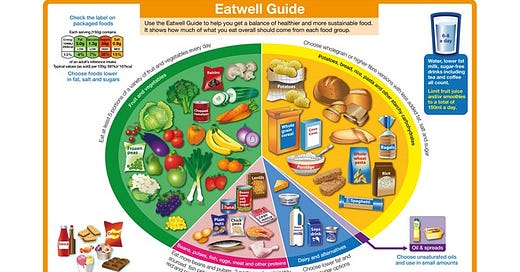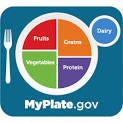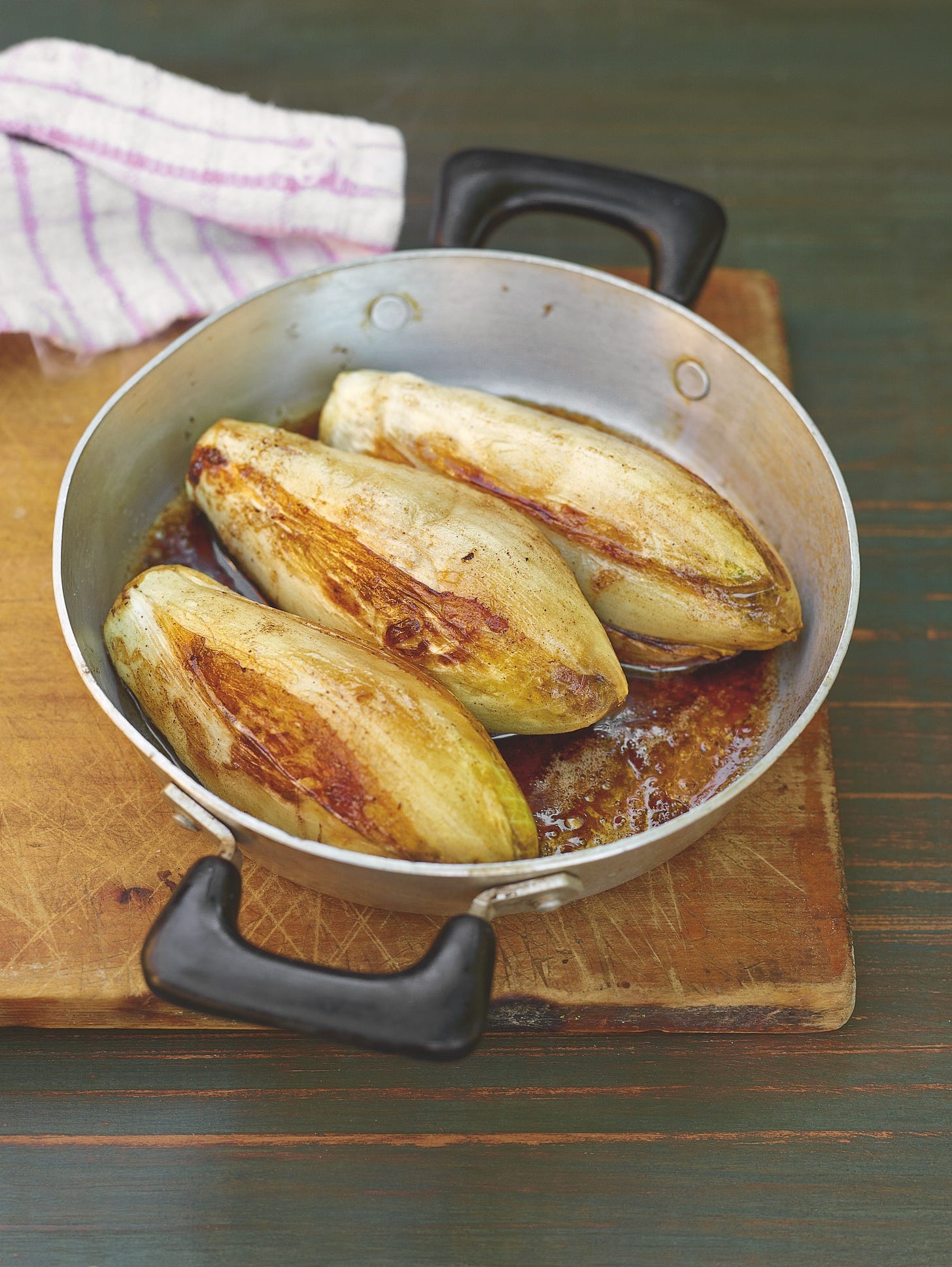You know all those guides supposed to jolt us into paying attention to our diets and making healthier food choices? The UK’s National Health Service Eatwell Guide is apparently followed by less than 0.1 percent of the population.
My grasp of maths is so poor I couldn’t tell you how many solid people that represents. If the palm of one hand constitutes 1 percent of the body surface area, is 0.1 percent of me just my thumb? And would 0.1 percent of the UK population be more than me plus Susan from next door?
In the US, the Department of Agriculture's food icon, MyPlate, which replaced the incomprehensible Food Pyramid, was itself discontinued on July 9 this year with no alternative yet proposed.
Apparently, only 25 percent of adults were actually aware of MyPlate. Fewer than 10 percent had attempted to follow the guidance. Not a success for an administration program costing around $3 million a year even as diet-related diseases such as obesity, diabetes and heart disease have continued to rise.
In the UK, every year 75,000 premature deaths are linked to poor diet. A study looking at the effect a change of diet and certain foods would have on an increase in life expectancy was recently published in Nature Food. A ‘high intake’ of milk and dairy, nuts and legumes, and vegetables, plus a ‘relatively low’ intake of red meat, sugar-sweetened drinks, along with a ‘moderate intake’ of whole grains, fish, fruit and white meat, and a ’low intake’ of processed meat and refined grains could add Methuselah-length years to our lives. (For those who need reminding, according to the Book of Genesis, Methuselah, son of Enoch, grandfather of Noah - he of that boat - died at the age of 969. You may agree with singers Lena Horne, Harry Belafonte, and Aretha Franklin that this might not be of benefit. Check the lyrics of It Ain’t Necessarily So: “Methuselah lived 900 years. But who calls that living when no gal is giving to no man of 900 years?”)
But if a Methuselah lifespan does appeal, eating more foods from that food combination could buy you a whole extra decade of life even if you’re already in your 70s.
This, though, depends on where you live. Geography has a significant impact on eating habits.
While climate change scientists globally are attempting to encourage a reduction of our red meat consumption, Argentina with its vast grasslands is the perfect environment for raising cattle. It has one of the highest rates of beef consumption in the world, the average Argentinian consuming around 120 pounds of beef a year. In the US, a mere 12 percent of Americans, most of them men between the ages of 50 and 65, account for half the country's beef consumption, say public health scientists at Tulane University. They eat at least 4 ounces of it every day, almost all of it from intensively farmed feed-lot raised animals, not pasture-roaming, grass-fed cows.
Meat-eating is associated with masculinity, an act of strength and dominance, and vegetarianism with wimps and women. On social media, shirtless men proudly gorge on steak. In Meathooked: The History and Science of Our 2.5-Million-Year Obsession with Meat, Marta Zaraska writes, “Recent scientific studies confirm that those of us who hold authoritarian beliefs…who seek wealth and power and support human dominance over nature, eat more meat than those who stand against inequality.”
Red meat enthusiasts in the US are more reluctant than European red meat fans to move to plant-based alternatives. The net revenue of Beyond Meat, US pioneer in the market, has fallen in the States by a whopping third. The company is in “survival mode”, with a net debt of $1 billion. It is banking on its expanding sales in Europe, where 51 percent of Europeans have reduced their meat intake (59 percent in Italy and Germany).
Advocacy hub Hungry for Action counts the number of people around the world affected by hunger as 735 million, with 3.5 billion unable to afford a healthy diet and 1 in 3 malnourished. Based on 13 first-world and developing countries, from the UK, US and EU, to Brazil, Kenya, Germany, India, Japan and more, their survey asked people what worried them most. “Supply and price of food” topped the list at 20 percent. Concern over food beat out:
government corruption - 17 percent
unemployment - 16 percent
rising cost of energy - 12 percent
conflict - 11 percent
heatwaves - 10 percent
wealth inequality - 8 percent
rising authoritarianism - 6 percent
37 percent of parents, in an IPSOS survey for World Vision International of 14,000 people in 16 countries, said their children failed to get proper nutrition and 21 percent have gone hungry in the last month. 74 percent of respondents to an ActionAid survey are shifting to low-quality cheaper food, with 48 percent of mothers reducing the amount of food they feed their children.
Alice Macdonald, campaign director of Hungry for Action, says “governments currently view the many elements of the global food crisis (namely unchecked climate change, food insecurity, malnutrition, fragile food systems and crippling debt) as separate issues - resulting in a piecemeal and fragmented response that not only ignores the interplay between these global challenges but misses opportunities for joint systems-level action that could drive progress in multiple areas.”
It would be hard to dragoon the British government into joined-up action on anything much except consulting each other over how best to approach the eating of grubs. Eight individuals directly or indirectly associated with the House of Commons have appeared or are currently appearing on the UK’s reality TV show I’m a Celebrity Get Me Out of Here instead of in Parliament.
As far as the UK’s food supply is concerned, in the view of the journal Sustainability, civil unrest due to shortages of common sources of carbohydrates – wheat, pasta, bread and cereal – is predicted to hit in the next decade. Stomachs rumbling constantly with hunger aren’t conducive to thinking much about why our politicians believe nibbling the exit regions of mammals on television is an appropriate way to steward the interests of their voters. Modelling himself on Mick Jagger and his devotion to his four red-meat devouring English mastiffs apparently were significant factors behind the recent election of Argentina’s new Prime Minister, volatile far-right libertarian Javier Milei. But do either qualify him for tackling that nation’s economic mismanagement and political dysfunction?
No-one needs to depend on red meat to feel manly. India, the second largest population in the world with 1.3 billion people, eats the least red meat, consuming only 3kg/6lbs of meat a year. Nine-in-ten Indians agree with the suggestion that a wife must always obey her husband, which presumably the Andrew Tates and Proud Boys of this world would find an entirely ‘manly’ tenet.
Anyone who wants to live as long as Methuselah should adopt a diet in which vegetables play a dominant role. This recipe takes endive and slow-roasts it with honey to temper its bitterness. It’s a great accompaniment to a pork or chicken roast that can be made more ‘manly’ as a solo dish if you wrap it in thin slices of Parma or Virginia ham. I include it not only because it tastes unexpectedly delicious but, more unexpectedly, when Martin Walker and I were invited onto ‘On My Mind’, Diane Rehm’s podcast on WAMU, to talk about Bruno’s Cookbook, this out of all the recipes is the particular one that she elected to discuss.
The pleasure of this dish lies in the contrast between bitter and sweet, like a good Negroni.
Serves 6
6 heads of Belgian endive (witloof)
1 1/2 tablespoons unsalted butter
Salt and freshly ground black pepper, to taste
4 tablespoons well- flavored honey
Trim the base of each Belgian endive making sure the leaves are still attached, and remove any damaged outer leaves. If they are particularly fat, halve them lengthwise. Melt the butter in a pan, and turn the endives in it. Season with salt and pepper then cover the pan and let them sweat and stew in their own juices over very low heat. Turn them regularly as each side becomes gold, until they have softened completely. Depending on their size, this will take 30 to 40 minutes. If they are browning too fast, add water, a tablespoon at a time. Test them for tenderness with the point of a knife. Don’t allow them to burn or their bitterness will become too emphatic. Add the honey, season if necessary with more salt and pepper, roll the endives thoroughly in the mixture, replace the lid and stew them another 5 minutes then turn them out onto a warmed serving dish, and pour the cooking juices over them.
Note: Because the honey plays a significant role, it’s worth using a good one, from a dedicated artisan small-batch producer, that has a discernible flavor.
If you want to up the ‘manly’ quotient, roll each endive in a slice or two of Parma or thinly-sliced Virginia ham. Make a béchamel sauce the thickness of heavy cream, lay the endive in a baking dish and coat them with the béchamel, sprinkle generously with cheese and bake in a 230C/450F oven 30 minutes until the top browns.








A wonderful article. You made so many interesting points, I may have to read it again to savor the content.
You mentioned the alternative meat trend in the US such as the products made by Beyond. They don’t taste bad, but are highly processed & full of sodium. I prefer other types of protein such as beans, nuts, eggs & cheese. Keeping it simple seems the best way to go.
Your recipe for endives sounds delicious & is now on my list. The 1st time my 🇫🇷 MIL sautéed endives in butter, I fell in love with the vegetable.
Thanks for penning such a thoughtful article. I will listen to the Diane Rehms podcast. (Love her!)
This looks delicious - I can't wait to try it! I also agree with the main thrust of your argument, though I'm curious about who you're counting in your I'm A Celebrity argument? As I said, I agree with you and I left working there because of the people, but I can only think of two politicians who have been to the jungle whilst they were supposed to be representing their constituents in the House of Commons?